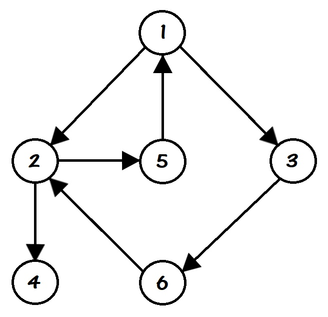308144: CF1472G. Moving to the Capital
Memory Limit:256 MB
Time Limit:4 S
Judge Style:Text Compare
Creator:
Submit:0
Solved:0
Description
Moving to the Capital
题意翻译
### 题意简析 有一个由 $n$ 个结点组成的有向图。一些结点由边长为1的有向边相连。 已知一个数组 $d_{1...n}$,其中 $d_i$ 为从编号为 $1$ 的结点到编号为 $i$ 的结点的最短距离。 你站在第 $s$ 个节点上。你有以下几种选择: 1. 沿着某条边,从第 $i$ 个结点到第 $j$ 个结点, $d_i<d_j$; 2. 沿着某条边,从第 $i$ 个结点到第 $j$ 个结点,$d_i\geq d_j$;(每局最多只能走一次) 你的目标是:靠近编号为 $1$ 的点。(准确地说,是找到从任意一个结点出发到第 $1$ 个结点的最短距离) ### 输入格式 第一行:整数 $t$,即数据组数。 每组数据以一个空行开头。 每组测试数据: 第一行:两个整数 $n,m$,分别代表点数,边数。 接下来 $m$ 行,每行两个整数 $u,v$,分别代表每条边的起点,终点。 ### 输出格式 每个测试数据一行,每行 $n$ 个整数,第 $i$ 个代表从第 $i$ 个结点出发到第 $1$ 个结点的最短距离。 ### 数据范围 $1\leq t\leq 10^4$ $2\leq n\leq 2\times 10^5$ $1\leq m\leq 2\times 10^5$ $1\leq u,v\leq n$ Translated by @[Cym10x](/user/354015).题目描述
There are $ n $ cities in Berland. The city numbered $ 1 $ is the capital. Some pairs of cities are connected by a one-way road of length 1. Before the trip, Polycarp for each city found out the value of $ d_i $ — the shortest distance from the capital (the $ 1 $ -st city) to the $ i $ -th city. Polycarp begins his journey in the city with number $ s $ and, being in the $ i $ -th city, chooses one of the following actions: 1. Travel from the $ i $ -th city to the $ j $ -th city if there is a road from the $ i $ -th city to the $ j $ -th and $ d_i < d_j $ ; 2. Travel from the $ i $ -th city to the $ j $ -th city if there is a road from the $ i $ -th city to the $ j $ -th and $ d_i \geq d_j $ ; 3. Stop traveling. Since the government of Berland does not want all people to come to the capital, so Polycarp no more than once can take the second action from the list. in other words, he can perform the second action $ 0 $ or $ 1 $ time during his journey. Polycarp, on the other hand, wants to be as close to the capital as possible. For example, if $ n = 6 $ and the cities are connected, as in the picture above, then Polycarp could have made the following travels (not all possible options): - $ 2 \rightarrow 5 \rightarrow 1 \rightarrow 2 \rightarrow 5 $ ; - $ 3 \rightarrow 6 \rightarrow 2 $ ; - $ 1 \rightarrow 3 \rightarrow 6 \rightarrow 2 \rightarrow 5 $ . Polycarp wants for each starting city $ i $ to find out how close he can get to the capital. More formally: he wants to find the minimal value of $ d_j $ that Polycarp can get from the city $ i $ to the city $ j $ according to the rules described above.输入输出格式
输入格式
The first line contains one integer $ t $ ( $ 1 \leq t \leq 10^4 $ ) — the number of test cases. Then $ t $ test cases follow. Each test case is preceded by an empty line. The first line of each test case contains two integers $ n $ ( $ 2 \leq n \leq 2 \cdot 10^5 $ ) and $ m $ ( $ 1 \leq m \leq 2 \cdot 10^5 $ ) — number of cities and roads, respectively. This is followed by $ m $ lines describing the roads. Each road is characterized by two integers $ u $ and $ v $ ( $ 1 \leq u, v \leq n, u \ne v $ ) — the numbers of cities connected by a one-way road. It is guaranteed that the sums of $ n $ and $ m $ over all test cases do not exceed $ 2 \cdot 10^5 $ . It is guaranteed that for each pair of different cities $ (u, v) $ there is at most one road from $ u $ to $ v $ (but a pair of roads from $ u $ to $ v $ and from $ v $ to $ u $ — is valid). It is guaranteed that there is a path from the capital to all cities.
输出格式
For each test case, on a separate line output $ n $ numbers, the $ i $ -th of which is equal to the minimum possible distance from the capital to the city where Polycarp ended his journey.
输入输出样例
输入样例 #1
3
6 7
1 2
1 3
2 5
2 4
5 1
3 6
6 2
2 2
1 2
2 1
6 8
1 2
1 5
2 6
6 1
2 3
3 4
4 2
5 4输出样例 #1
0 0 1 2 0 1
0 0
0 0 2 1 1 0